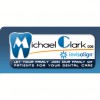
We have always considered it a great honor whenever a patient joins our practice and places trust in us for their dental care. We spend our days trying to continue to earn that honor with every patient visit. Our practice schedules patients so that there is very little wait and you will have ample time to discuss your care with Dr. Clark. We have always been commited to providing up to date care in dentistry and have also commited by being very high tech.
Dr. Clark was the first dentist in the Pittsburg - Frontenac area to provide air abrasion dentistry, which allows for many procedures to be done without shots or drills. We are the first to have computerized dental records and digital X-rays. Dr. Clark and his staff believe the patients of southeast Kansas deserve the best dentistry offered in the United States and not just have to settle for what is available here.
Dr. Clark spends many hours each year in continuing education classes to ensure we have a cutting edge practice. Our professional and caring staff is committed to this philosophy of patient care with a capital C.
Dr. Clark was the first dentist in the Pittsburg - Frontenac area to provide air abrasion dentistry, which allows for many procedures to be done without shots or drills. We are the first to have computerized dental records and digital X-rays. Dr. Clark and his staff believe the patients of southeast Kansas deserve the best dentistry offered in the United States and not just have to settle for what is available here.
Dr. Clark spends many hours each year in continuing education classes to ensure we have a cutting edge practice. Our professional and caring staff is committed to this philosophy of patient care with a capital C.
Services
I was born in Pittsburg in 1965.
I attended Frontenac Grade School and High School, graduating in 1984.
I spent the next 4 years at Pittsburg State University and was accepted to UMKC School of Dentistry in 1988.
After graduating from dental school with distinction and in the top 10% of my class, I was one of four students accepted into UMKC's Advanced Education in General Dentistry program.
The AEGD program was an intense year spent providing care to patients who had difficult cases.
Upon completion of the program in 1992, I opened my current practice in Frontenac.
I attended Frontenac Grade School and High School, graduating in 1984.
I spent the next 4 years at Pittsburg State University and was accepted to UMKC School of Dentistry in 1988.
After graduating from dental school with distinction and in the top 10% of my class, I was one of four students accepted into UMKC's Advanced Education in General Dentistry program.
The AEGD program was an intense year spent providing care to patients who had difficult cases.
Upon completion of the program in 1992, I opened my current practice in Frontenac.
We strongly adhere to the principle "Prevention is better than cure".
We stress regular, periodic checkups and cleanings.
We take selective, judicious x-rays to diagnose dental problems in the early stages, before they become major, expensive repairs.
Children also receive periodic applications of fluoride on the teeth to strengthen them against cavities.
We also strongly advise all parents to have their children's teeth protected from getting cavities on the chewing surfaces of teeth by placing sealants on the teeth.
We stress regular, periodic checkups and cleanings.
We take selective, judicious x-rays to diagnose dental problems in the early stages, before they become major, expensive repairs.
Children also receive periodic applications of fluoride on the teeth to strengthen them against cavities.
We also strongly advise all parents to have their children's teeth protected from getting cavities on the chewing surfaces of teeth by placing sealants on the teeth.
A preventive program is a cooperative effort by the patient, dentist, and dental staff to preserve the natural dentition and supporting structures by preventing the onset, progress, and recurrence of dental diseases and conditions.
Preventing dental disease starts at home with good oral hygiene and a balanced diet.
It is continued in the dental office by the efforts of your dentist and dental hygienist to promote, restore, and maintain your oral health.
Prevention also includes regular dental exams, cleanings, and x-rays.
Preventing dental disease starts at home with good oral hygiene and a balanced diet.
It is continued in the dental office by the efforts of your dentist and dental hygienist to promote, restore, and maintain your oral health.
Prevention also includes regular dental exams, cleanings, and x-rays.
A dental filling is a type of restorative dentistry treatment used to repair minimal tooth fractures, tooth decay or otherwise damaged surfaces of the teeth.
Dental filling materials, which include composite, porcelain and silver amalgam, may be used to even out tooth surfaces for better biting or chewing.
Enamel loss is a common component of tooth decay, and may result in tooth sensitivity.
In many cases, tooth sensitivity caused by enamel loss will be significantly improved or completely eliminated once an appropriate dental filling material is placed.
Dental filling materials, which include composite, porcelain and silver amalgam, may be used to even out tooth surfaces for better biting or chewing.
Enamel loss is a common component of tooth decay, and may result in tooth sensitivity.
In many cases, tooth sensitivity caused by enamel loss will be significantly improved or completely eliminated once an appropriate dental filling material is placed.
A root canal is a dental procedure that is used to remove diseased pulp tissue from the interior of a tooth.
The narrow channels beneath the pulp chamber in the inner part of the tooth are hollowed out and cleaned, and the roots are filed with flexible nickel titanium files.
A tooth is made up of three main components: a hard protective shell referred to as enamel, a softer and sensitive middle layer referred to as dentin and a soft tissue inner layer referred to as dental pulp.
Dental pulp is composed of nerve tissue, lymph tissue and blood vessels, and is considered to be the vital part of a tooth.
The narrow channels beneath the pulp chamber in the inner part of the tooth are hollowed out and cleaned, and the roots are filed with flexible nickel titanium files.
A tooth is made up of three main components: a hard protective shell referred to as enamel, a softer and sensitive middle layer referred to as dentin and a soft tissue inner layer referred to as dental pulp.
Dental pulp is composed of nerve tissue, lymph tissue and blood vessels, and is considered to be the vital part of a tooth.
Reviews

Be the first to review Clark Michael E, DDS.
Write a Review

